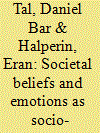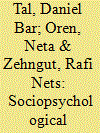|
|
|
Sort Order |
|
|
|
Items / Page
|
|
|
|
|
|
|
| Srl | Item |
| 1 |
ID:
129797


|
|
|
|
|
| Publication |
2014.
|
| Summary/Abstract |
An outsider observing the Israeli-Palestinian conflict might ask him or herself why, after so many attempts and initiatives have been placed on the negotiations table, the adversaries have failed to reach a settlement. Indeed, the "two-state solution" paradigm has been accepted by the majority of people in both societies for over a decade now (Bar-Tal, Halperin, & Oren, 2010), but the parties appear still far from reaching the desired resolution. Moreover, the solutions proposed over the years of negotiations by both officials and non-officials follow a similar paradigm and have in fact established clear contours to a possible peaceful resolution of the conflict. In fact, the Clinton Parameters from 2001, the Arab Peace Initiative from 2002, and Israeli Prime Minister Ehud Olmert's proposal from 2008 all identify the need to partition the land along the 1967 borders, transfer control of the eastern neighborhoods of Jerusalem to the Palestinians, find a fair solution to Jerusalem's holy sites, and formulate a just and agreed-upon solution to the Palestinian refugee problem (Lavie, 2010). Thus, one might ask: If the solution is so clear, what is holding the parties back?
|
|
|
|
|
|
|
|
|
|
|
|
|
|
|
|
| 2 |
ID:
134157


|
|
|
|
|
| Publication |
2014.
|
| Summary/Abstract |
Societies involved in intractable conflicts form conflict-supporting narratives that illuminate and justify their intergroup conflicts. These narratives play an important role in satisfying the basic sociopsychological needs of the involved individuals and collectives. In order to fulfill this role the narratives tend to be biased in favor of the in-group, selective, distorting and simplistic. This article analyzes such narratives that focus on the following major themes: Justification and Threats (of conflict), Delegitimization (of the opponent), Glorification and Victimhood (of the in-group), the in-group's need for Patriotism and Unity, and its Aspiration for Peace. Additionally, the article describes the individual and collective functions of these narratives. It also describes six main methods that are used in the narratives' construction: reliance on supportive sources, marginalization of contradictory information, magnification of supportive themes, fabrication of supportive contents, omission of contradictory contents, and use of framing language. Because conflict-supporting narratives are so functional, the involved societies struggle to support their dominance within their own society as well as in the international community. This article, therefore, presents seven methods that are used by the parties in their intrasocietal struggles - control of access to information, censorship, discrediting of contradicting information, monitoring, punishment, encouragement and rewarding, and closure of archives. Similar methods are used in the international arena struggles. Finally, it describes the process of change from adherence to the conflict-supportive narratives to the construction of new peace-supporting narratives and Adherence to Them.
|
|
|
|
|
|
|
|
|
|
|
|
|
|
|
|
|
|
|
|
|